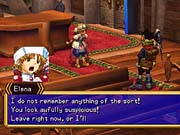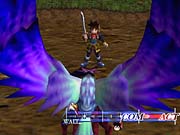Grandia II Preview
The Dreamcast RPG from GameArts is coming to the PC. Find out what you can expect from the port.

Released in 1997 on the Sega Saturn, the original Japanese version of Grandia was widely considered to be one of the finest console RPGs ever crafted, surpassing even Square's widely praised Final Fantasy VII, which was also released around the same period. Unfortunately, the Sega Saturn version never made it to domestic shores due to a general lack of interest in the console, but recognizing Grandia's immense popularity in the Japanese market, Sony bought the rights to the game and released it for the US PlayStation in 1999. When Grandia II was announced for the Dreamcast, Ubi Soft quickly snapped up the rights to distribute it on multiple platforms outside of Japan, including the PC. While the console style of the gameplay may alienate fans of traditional PC RPGs, those who enjoyed the PC versions of Square's Final Fantasy games have something to look forward to this December.
Grandia II's storyline essentially has nothing in common with that of its predecessor, as it begins with a brief animation sequence, showcasing the battle between Granas and Valmar--otherwise known as the gods of good and evil, respectively. In the battle, Granas uses a weapon of immense power to strike the final defeating blow against Valmar, and that blow also opens up an enormous chasm in the continent of Silesia. Granas then severs Valmar's body into several pieces and seals the pieces away in different parts of the continent to prevent his return. Long after the battle, people scatter throughout Silesia and establish towns and settlements, some of which are in direct contact with areas known to harbor one of Valmar's appendages. Because of a sudden resurgence of odd creatures in the area, the members of the church of Granas located in the small town of Carbo begin to believe that seal confining Valmar's wings--located in a tower near Carbo--is on the verge of collapse.

Your quest begins with the introduction of Ryudo, a traditional rebel character who comes from a group of people known as the Geohounds, who are seemingly frowned upon by other inhabitants of Silesia, particularly the religious zealots. Since Ryudo's a mercenary of sorts, he accepts various jobs in exchange for enormous amounts of money. As Ryudo, one of your first tasks is to escort a songstress named Elena to the tower so she can participate in a sealing ceremony. Naturally, the sealing ceremony doesn't proceed as planned, and Valmar comes one step closer to being reborn.
Grandia II's storyline progresses largely through in-game cutscenes and extensive dialogue sequences that take place between the key characters and secondary characters who roam throughout Silesia's villages. Some of the more important characters, such as Ryudo and his eagle companion Skye, have occasional spurts of actual spoken dialogue provided by experienced voice actors like Cam Clarke (the voice of Liquid Snake in Metal Gear Solid) and Paul Eiding (the voice of Colonel Campbell in Metal Gear Solid 2). Characters will also speak while performing special maneuvers during battles.
No Chocobos Here

Unlike the Final Fantasy series, there are no random battles in Grandia II. When you enter a dungeon or any other area where enemies are located, they'll be completely visible, giving you the ability to decide whether or not you want to fight or run straight to the objective. However, it's a little more challenging than it may seem. Whenever you walk into the line of sight of an enemy, it will turn red, indicating that it has spotted you and will begin to charge. If you're not facing the direction of the enemy, then it's given the opportunity to launch the first attack upon entering the battle sequence. Likewise, if an enemy doesn't detect you before you engage it in battle, then you're given the chance to strike first. While it may seem like an easy alternative, running from enemies actually prevents you from gaining experience and learning new skills, ultimately making inescapable battles all the more difficult.
Grandia II's battle system is somewhat similar to the one introduced in the Final Fantasy series, though it's a little more complex. When you enter the full 3D battle area, a small meter appears in the lower right-hand portion of the screen. This meter indicates the amount of time you have until you're able to select an action, and depending on the strength of the action, it also shows how much time until it's executed. What makes the battle system interesting is the fact that the meter also shows when the enemy can perform an attack, forcing you to think of a strategy that involves precise timing. For example, Ryudo basically has four battle options available--a basic combination attack, a critical attack, a spell/special attack, and an item (using grenades or similar items) attack. The basic combination attack deals the least damage, but there's no secondary waiting period before execution and it can counter basic enemy attacks. Since the three other options are generally more powerful than the combination attack, they all require additional time before they can be performed, leaving Ryudo, or any other character in the four-person party, vulnerable to multiple enemy attacks. But the results of the high-level attacks are undeniably devastating to an enemy. Fortunately, enemies have to abide by the same rules as your characters do, so while they're attempting to execute spells, you can easily launch two basic attacks or a spell attack before they even move.

When a battle ends, you receive experience that your characters use to gain levels, as well as coins that can be used to buy additional special or spell attacks. None of the characters in Grandia II fall within specific classes, so each can have a healthy balance of special-weapon and spell attacks. It's also possible to load a character with spell attacks and completely neglect other abilities if that's what appeals to you.
Since Grandia II was originally designed for the Dreamcast, Grandia II's visuals are on par with those of most present-day RPGs. The gameworld is rendered in full 3D, making it possible to rotate the camera to look at some of the finer details, especially while you're in one of the towns. The character models, though lacking prominent facial features, are decked out in colorful and detailed clothing, and they have also been animated with fairly realistic movements. Also worthy of note are the spectacular spell effects, which are actually done by overlaying MPEGs over the characters instead of doing them in real time--some even involve brief anime sequences.
The only real problem with the PC version of Grandia II at the moment is the absolutely horrid frame rate. Even set at the lowest graphical setting, the game has almost obscene amounts of slowdown that even causes the dialogue text to stutter. Hopefully, Ubi Soft will have this problem fixed before the final release and give Grandia II the proper port that it deserves. It's currently scheduled for release on December 18.
Got a news tip or want to contact us directly? Email news@gamespot.com
Join the conversation